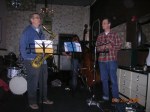I managed to get to the Go Left Fest at Yoshi’s San Francisco last night, and it was awesome. Six acts, headlined by Matthew Shipp (piano) / Marshall Allen (sax, EVI thingie) / Joe Morris (bass). Not a sellout crowd, sadly, but a warmly receptive one, folks who very much came to hear this kind of music.
Six acts in all, spanning four hours, including intermissions of varying length between acts. I’ve only got time to skim through the specifics.
The important thing is: They’re doing it again tonight (Tuesday June 23) and probably wouldn’t mind your support … It’s very hard for folks like these to tour the west coast, so it would be great to encourage Yoshi’s to continue sprinkling some outside acts into its schedule…
Anyway, the acts:
1. Beth Custer trio/quartet: A couple of pieces from her current Buckminster Fuller project, a couple of jazzy songs, and a catchy old-school jazz stomp called “Wag the Puppy,” written by guitarist David James.
2. Positive Knowledge: Oluyemi and Ijeoma Thomas (reeds, poetry) plus drummer Sunny Murray in the chair Spirit normally occupies. One long piece with lots of phases; generous applause for some of Oluyemi’s more breathtaking, overblowing solos on bass clarinet and soprano sax. Positive Knowledge weaves a spell of joyous improvised jazz, not only in Oluyemi’s playing but in Ijeoma’s recital, which often dips into abstract vocal sounds before returning to grounded, pre-written material. Sunny Murray was in a great mood, joking around with the audience while the band set up.
3. Myra Melford/Mark Dresser: Piano and bass, doing chamber-like compositions with a jazz jump to them (Melford’s specialty) and of course lots of improvising in the middle. Great rapport. My angle, behind the piano, was perfect for this set — I could see Melford’s light touch on the keys (even when she was splashing big chords with palms and wrists) and Dresser’s face and the top of the bass’ fingerboard. They finished with a really fun, small piece that gave Dresser a chance to goof around.
4. Ismael Reed: An author and poet, Reed performed with a band of sax (or clarinet or flute), piano, guitar, and drums. (Sunny Murray again, IIRC.) He started heavy, with pieces about the nonsensical waste of war and the unfair villification of “welfare queens.” Most of the remaining pieces dealt with jazz and jazz icons. Straight-up jazz backing throughout. Reed ended with the band playing “That’s What Friends Are For” — a bit cheesy, but his text was a thank-you note to various organs (heart, liver, and brain, mainly) for getting him this far.
5. Roswell Rudd: With Lafayette Harris on piano, who didn’t get enough credit from the crowd for his mix of standards-jazz styles, avant-garde dissonances, and rhythm-opening spacing. The set, sometimes augmented by trumpeter Earl Davis, was a mix of inside-out pieces (fairly straight stuff with free-ranging soloing) and some out-there screechiness. Fun, but Rudd lost track of the time; he announced a waltz piece written for his wife’s recent birthday but didn’t have time to play it. “You’ll hear that one tomorrow!” he said.
6. Marshall Allen, Matthew Shipp, Joe Morris: Playing together for the first time, and you always wonder if “first time” is going to be a letdown. It wasn’t. Shipp was stormy on piano throughout — in fact, I don’t think he ever stopped playing during any of the three or four long improvisations they did, aside from a Morris bass solo early on.
Allen was in prime form, wearing an Arkestra outfit and playing what I think was the “EVI,” an electronics gizmo controlled by a combination of breath, buttons, and dials. Lots of futuristic weirdness to be had there. The EVI produced the same kinds of sounds you’d get from laptop electronics, but with a more direct sense of control. It fit well but was turned up a bit too loud; Shipp’s playing is so tumultuous, it ought to eclipse the sax/reeds voice in spots, I think.
Again, I was behind the piano, so I got to watch the Matthew Shipp fireworks show. Man, he’s terrific. His hands seem to be flying everywhere in random stabs, but the chords that come out make so much sense. (Caveat: I suspect any pianist playing free jazz is like that.) He’s got a couple of trademark moves that were interesting to see in person — like one where he pokes a chord stacatto and (I think) hits the sustain pedal an instant too “late,” for a distant kind of echo/reverb. I’d never seen Shipp play before, so this was a particular treat. I’m going to go put his Symbol Systems solo CD on now.
Joe Morris gets a raw deal here — not only is the bassist often the hardest element of a combo to describe, but I couldn’t get a clear view of him with the piano blocking the way. His mercury-fluid guitar style does seem agreeable to the fast, wide-ranging wanderings of free-jazz bass, and that theory proved out well in this set.














